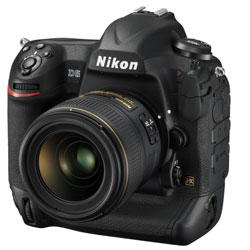Nikon has announced the March release of its newest professional-grade flagship model, the D5 – a 20.8 megapixel camera boasting a new autofocus system and the ‘highest standard ISO sensitivity in Nikon history’ – which goes up to 102,400.
 While appearing strikingly similar to the D4, the D5 will cost over $10,000 which seems ambitious, but there’s a few totally new features in this camera that may justify the high price tag.
While appearing strikingly similar to the D4, the D5 will cost over $10,000 which seems ambitious, but there’s a few totally new features in this camera that may justify the high price tag.
Nikon has aimed this camera toward professional photographers seeking fast performance, reliable autofocus and low-light capabilities. Megapixels are of less interest to Nikon in this camera – it’s all about fast and precise autofocus capable of tracking fast-moving subjects.
Nikon overhauled the autofocus system in the D5 with a new 153-point AF system, 99 of which are cross-type sensors, giving it an AF sensitivity down to -4 EV for shooting in low-light conditions. The cross-type sensors have been placed around the edge of the focusing area allowing it to capture subjects in the periphery of a frame with clarity.
The new AF system has been received well in the tech media and sports photographer Matthias Hangst, who was part of the Nikon Press Event, said the D5 is a ‘game-changer’ for sports photographers, with ‘brilliant’ tracking of erratic movement.
The D5 can shoot at 12fps with AF in Continuous high speed release mode with a shutter speed of 1/250 or faster, and 14fps without AF.
Additionally the RGB metering sensor has been upped to 180,000-pixels, which Nikon says will provide more accuracy and precision when tracking objects in continuous AF.
Back to the high standard ISO sensitivity; Nikon has used a a new processor it calls Expeed 5 which spans the native ISO range from 100 to 102,400. Nikon also claims an ‘extended range’ of 3,280,000 – up from a now rather pathetic ISO 409,600 available in the D4S.
‘Remarkable, ground-breaking and once-in-a-lifetime shots can happen in the blink of an eye. Whether you’re shooting in unexpected conditions or with volatile subjects, the Nikon D5’s high sensitivities and subject acquisition capabilities allow photographers to take advantage of unpredictable situations,’ said James Murray, director of Sales & Marketing, Nikon Australia. ‘No matter what shooting environment photographers are faced with, the D5 is engineered to outperform all expectations with ease of operation, accuracy and exceptional reliability.’
The D5 is Nikon’s first DSLR capable of capturing 4K ultra HD (3840 x 2160)/30p video, as well as 1080p video at 50p/60p, with the option of using the HDMI output to view video on an external monitor or recorded to an external recorder. But it’s worth noting the 4K capabilities are limited as recording is significantly cropped and can only record 3 minute intervals.

Hangst said that water polo is challenging to shoot with AF due to the speed and the way light splashes around during gameplay. But the D5 manages to work well in such conditions. Source: Nikon.
At the Nikon Press Event at CES 2016, the global tech and electronics tradeshow in Las Vegas, senior vice president of Nikon, Nobuyoshi Gokyu, briefly discussed the D5’s moving mirror system, which he says outruns the best of today’s mirrorless lineup, Imaging Resource reported from the ground.
The camera weighs 1.4kgs and is available in two bodies – one equipped with dual XQD card slots and the other with traditional dual CF cards slots. These can be swapped over.
Other features include:
– High-res 3.2 inch, 2.36-dot touch screen LCD monitor;
– Built-in 1000 base-T 400mbps Ethernet connections (1.5x faster than D4S);
– USB 3.0;
– Magnesium alloy, weather sealed body;
– Available separately, the Wireless Transmitter WT-6 allows high-speed wireless transfers with network communication.
While Nikon Australia doesn’t supply pricing in its press statements, the US ‘manufacturers suggested retail price’ is US$6500, which converts to A$9120. Add GST or even just the so-called ‘Australia Tax’ and it becomes a $10K+ purchase. Ouch! – With digital camera bodies becoming obsolete much faster than film bodies – think Nikon FM2, for instance – and the fees photographers are able to command under downward pressure, it will be a challenge to get to a break-even point and into profit with a $10K camera body.

